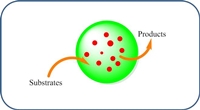| Bio-nanotechnology is a multidisciplinary field that requires knowledge of chemistry, biology to manipulate and generate nanomaterials for desired applications. The nanoparticles (NPs) can be engineered to achieve different sizes, shapes, and surfaces for drug delivery, imaging, sensing, and for understanding of basic biological phenomena (Figure 1). Our research interests are in the areas of design, synthesis, assembly, and engineering of nanoparticles for chemical and biomedical applications. |
 Figure 1 Our research theme: nanoparticles are synthesized for chemical and biomedical applications. |
Nanoreactors |
| Polymeric nanoparticles or polymersomes are formed via self-assembly methods in aqueous solution due to their amphiphilic behavior (Figure 2). They can be tuned to desired sizes for specific pathways of administration, improved stability, stimuli responsiveness and can be engineered for targeting approaches depending on polymer properties and hydrophobic/hydrophilic ratio (1). |
| One of the most important applications of these nanoparticles is using them as a nanoreactor. In this application, the polymeric vesicles are not only protecting enzyme from proteinase and chemical degradation but also serve as a confined reaction vessels. Since enzyme reactions in nature usually occur in confined space, the nanoreator may both increase stability of enzymes and provide unobserved information about enzyme kinetics. The different types of polymers will be carefully designed and optimized to prepare nanoreactor system for desire purposes. This nanoreactor concept has wide range of applications such as biocatalytic, biosensors, diagnostic, or enzyme replacement therapy. |
 Figure 2 Polymeric nanoparticle preparation method. |
| Bioimaging application |
| Fluorescent nanoparticles can be made of different materials such as quantum dots (Figure 3), metal NPs, silica, and polymer. The fluorescent nanoparticles have unique properties, for example, they are brighter, more stable and biocompatible compared to conventional organic fluorescent dyes (2,3). Since the nanoparticles have such excellent properties, different types of fluorescent nanoparticles will be synthesized which can be used for biological and medical applications such as bio-labelling or using as bio-sensing systems. |
 Figure 3 An example of fluorescent nanoparticles and its application. Quantum dots (CdSe/ZnS core-shell NPs) provide different colours and can be used to target specific cells. |
| Nanoparticles-cell interactions |
| The nanoparticles have been rapidly developed to use in many applications especially in nanomedicine. The nanoparticles can be varied from different materials, sizes, and surface modifications for different purposes. However, there is still a lack of understanding about the interaction between nanoparticles and cells. This is very important area to study not only to provide a better understanding of nanoparticle behaviour but also help us to improve the development of nanoparticles that can be targeted to specific cells/organelles. Therefore, we will focus on how different nanoparticles interact with cells especially in complex environments (4-6). |
 Figure 4 Nanoparticles and cell interactions. |
| 1. Tanner, P., Baumann, P., Enea, R., Onaca, O., Palivan, C., and Meier, W. (2011) Polymeric Vesicles: From Drug Carriers to Nanoreactors and Artificial Organelles. Accounts of Chemical Research 44, 1039-1049 2. Ruedas-Rama, M. J., Walters, J. D., Orte, A., and Hall, E. A. H. (2012) Fluorescent nanoparticles for intracellular sensing: A review. Analytica Chimica Acta 751, 1-23 3. Prapainop, K., Witter, D. P., and Wentworth, P. (2012) A Chemical Approach for Cell-Specific Targeting of Nanomaterials: Small-Molecule-Initiated Misfolding of Nanoparticle Corona Proteins. Journal of the American Chemical Society 134, 4100-4103 4. Zarschler, K., Prapainop, K., Mahon, E., Rocks, L., Bramini, M., Kelly, P. M., Stephan, H., and Dawson, K. A. (2014) Diagnostic nanoparticle targeting of the EGF-receptor in complex biological conditions using single-domain antibodies. Nanoscale 5. Salvati, A., Pitek, A. S., Monopoli, M. P., Prapainop, K., Bombelli, F. B., Hristov, D. R., Kelly, P. M., Aberg, C., Mahon, E., and Dawson, K. A. (2013) Transferrin-functionalized nanoparticles lose their targeting capabilities when a biomolecule corona adsorbs on the surface. Nat Nano 8, 137-143 6. Prapainop, K., and Wentworth Jr, P. (2011) A shotgun proteomic study of the protein corona associated with cholesterol and atheronal-B surface-modified quantum dots. European Journal of Pharmaceutics and Biopharmaceutics 77, 353-359 |
